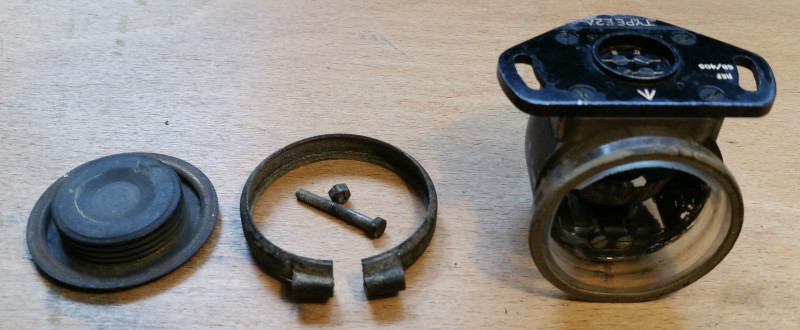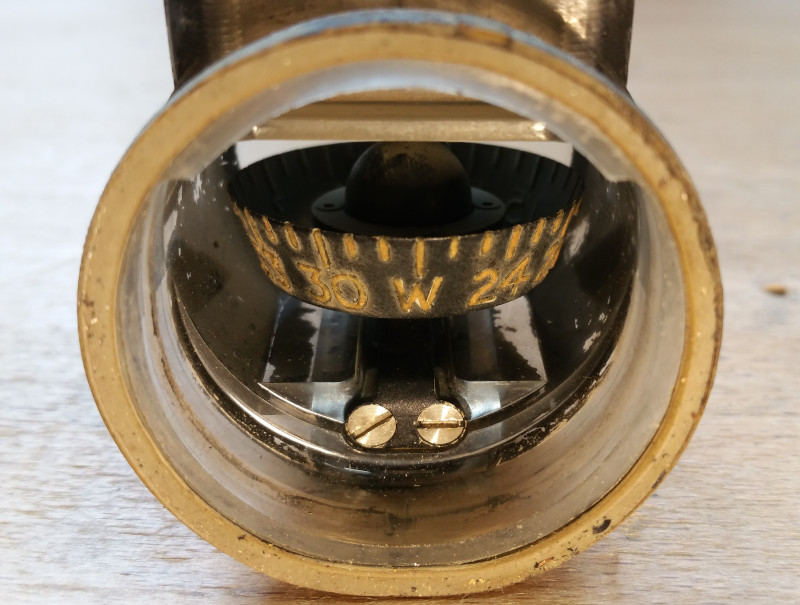
STANDBY COMPASS TYPE E2B
LEADING PARTICULARS
| Stores Ref. No.: | 6B/2754 |
| Manufacturer: | Kelvin & Hughes (under Smiths) |
| Attachments: | 28D/1212964 | A61/1B | Bolt, 4BA hex. head, Light Alloy | Qty: 2 |
| Attachments: | 28M/1956039 | AGS.2001/B/3 | Nut, stiff, 4BA, Light Alloy | Qty: 2 |
| Connection: | 6B/2755 | CE2/A26 | Lead and Socket Assembly (5ft.) |
DESCRIPTION
Mounted to the central windscreen strut, the Type E2B compass acts as a standby in case of failure of the navigation display and directional indicator, both of which are dependent on AC power, ie: this compass is required under a total AC power failure.
The E2B is part of the E2 series of compasses, all of which utilise a clear bowl containing magnetic compass card. Earlier bowls were made from Perspex, however a modification in the 90's introduced a polycarbonate bowl. The magnetic compass card sits on a central pivot, its motion damped by a silicone fluid in the bowl.
All E2 series compasses include a horizontal corrector assembly mounted to the mounting plate to compensate for magnetic affects of the airframe correcting Coefficients B and C. Coefficient A is corrected for by setting the mounting plate position using the slotted bolt holes. Only the E2 includes a vertical corrector assembly for Coefficient R.

Exploded diagram of E2B compass from SP514

Kelvin & Hughes E2A compass advert - Flight 02-03-1951
Source: aviationancestry.co.uk
DONATION
Rather amazingly, a total stranger donated an E2A compass (Stores Ref. No.: 6B/405) to this project, as thanks for pages of my website he found useful in progressing his own simulator project! Many thanks go to Roger Lee.
This donated compass came from Rogers old Druine Turbulent aircraft G-APYZ, that crashed in 1974.

G-APYZ before and after 1974 crash
(images courtesy Roger Lee)
As the E2A shares the majority of its componets with the E2B (just minus the light fitting), it is a good candidate to use in this Lightning flight simulator.

Donated E2A compass from G-APYZ before restoration
RESTORATION
When the donated compass arrived, it still carried traces of soil / dust from the crash (nearly 50 years on), and the liquid had long since disappeared. The bowl had acquired a few accidental brush strokes of black paint (possibly form a cockpit re-vamp) and part of the lower perspex bracket was broken away, but it had potential to very closely represent the E2B compass used in the Lightning.
Disassembly & Cleaning
I started by gently scraping away the brush strokes of unwanted paint from the bowl with the side of a screwdriver blade, taking care not to damage the perspex bowl (16). After all unwanted paint was removed, the outer surfaces were cleaned of all dust and grime with a stiff nylon brush and damp wipes.

I opened the compass by removing the bellows retaining clip (2), and withdrawing the bellows (1). This took some gentle pursuasion to release the bellows form the bellows gasket (6)

Two screws (9) hold in place the stem assembly (7), these were removed, and the stem assebly slid out complete with compass card assembly (11) and pivot / nut (12). These parts and the inside of the bowl were all cleaned by gently wiping with a damp tissue. The residue left by the previous fluid came off easily.


The horizontal corrector assembly (12) was removed, the gears were choked in dust, which was cleaned out using the nylon brush and air.

Repair
Prior to the strip down, I had noticed that the compass card (10) was not sitting straight on its pivot. Once the card assembly was out, it became clear that the pivot and nut (11) were bent off to one side, there is a possibility this may have been as a result of the crash impact.

Using a pair of fine nosed pliers and spirit level, I was able to gently straighten the pivot pin in relation to the card, to attain a level sitting compass card.
Rebuild
As with most projects like this, the rebuild was just the reverse of dismantle. As I have no torque figures for the screws, I took extra care when tightening the screws into the perspex bowl so as not to strip the threads or casue a crack.

Post-restoration, awaiting silicone fluid refill
Compass Fluid
After reading many online opinions on the fluid to use in the compass bowl varying from solvents such as IPA to baby oil. However I found several references in the documentation to the use of a silicone fluid.
Quote: AP112B-0201-13A, Amdt 15, Feb 1990, Compass Standby Magnetic, Paragraph 4
4 The compass bowl is completely filled with silicone fluid chosen because it has no detrimental effect on the material used in the manufacture of the bowl, and becasue its temperature viscosity changes are small. A bellows at the rear of the bowl caters for change of volume of the liquid with variation of temperature.
A quick look on ebay, I found many options for silicone fluid, mainly used as a lubricant for treadmills, however, with no knowledge on the required viscosity just buying one to try was a bit of a shot in the dark and may have resulted in failure. Again, examining the documentation, a specification was found:
Quote: SP514, Issue 2, March 1957, Spare Parts List
1 ½ oz | GS-766 | Silicone Fluid, M.S. 200/3
However, so far I have been unable to find and reference to this part number or specification online.
Caution: In cleaning the compass card, I tried a little MEK solvent in an attempt to brighten the white markings (which remained distinctly un-brightened), however the black paint was easily dissolved... ie: don't attempt to fill these compasses with solvents.
SIMULATION
As the E2A had no light fitting underneath, this allowed me the opportunity to make a false light fitting (making it look more like an E2B) which can contain some coils that I can power to set up a magnetic field according to the simulated aircraft heading, hopefully with enough flux to rotate the compass card.
Experiment No. 1
I hand-wound a coil of 40 turns which drew about 1.5A while connected to a AAA cell. This placed below the compass bowl within the area of the lower bracket did demonstrate that the compass card could be controlled. Until I can fill the bowl though I will postpone more experiments as the overshoot and stability is an issue.
REFERENCES
Smiths literarure:
34-04-70-DM, 29-11-1957, Maintenance Manual E2 Series Compasses
Smiths Leaflet C2-1, E2 Series Compass
Kelvin & Huhges / Smiths E2 Sereis Compasses (1957):
SP514, Issue 2, March 1957, Spare Parts List
E2 Series Compass General and Technical Informaion (1957):
AP1275B, Vol 1, Sect 10, April 1957, Compasses, Magnetic, E2 Types (Note: Fig 1 erroneously shows E2B)
E2 Series Compass General and Technical Informaion (1990):
AP112B-0201-13A, Amdt 15, Feb 1990, Compass Standby Magnetic
E2 Series Compass General Orders and Modifications (1990):
AP112B-0201-2, 1st Edition, Feb 1990, Compass Standby Magnetic
Flying, Aircraft and Equipment (circa 1950's):
AP129, Volume 1, Part 2, Section 3, Chapter 4, Self Contained Magnetic Compasses
Standard Technical Training Notes - Compasses (1968):
AP3280A, Section 3, Chapter 1, A.L.32, Oct 1968, STTN Compass Adjustment
F Mk. 3, T Mk. 5 and F Mk. 6 aircrew manual:
A.P.101B-1003, 5 & 6A, Part 1, Chapter 7, A.L.2, Nov 1984 - Instruments - Paragraph 51
T Mk.5 Electrical "Vol. 1":
AP101B-1005-1B, Section 7, Chapter 5, A.L. 60, October 1973 - Flight Instruments - Paragraph 11
T Mk.5 wiring diagrams:
AP101B-1005-10, Sheet 36, A.L.3, Nov 1981, Cabin Lighting, Port
AP101B-1005-10, Sheet 37, A.L.3, Nov 1981, Cabin Lighting, Starboard